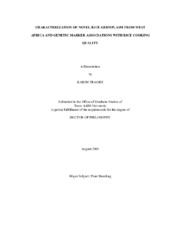| dc.description.abstract | Genetic resource enhancement is the foundation of any good breeding program.
Landraces from West Africa, interspecifics between Oryza sativa and Oryza glaberrima
and improved lines from the West African Rice Development Association and other
research centers were introduced to the Beaumont Rice Research center for in situ
evaluation and characterization. Beside the introduction of seeds, milled samples were
also introduced for grain chemistry analysis. Field evaluation combined with physicochemical
and molecular characterization revealed unique characteristics among African
germplasm. New rice for Africa (NERICA) lines performed well in the USA
environment. Varieties like Nerica 2, Nerica 3, Nerica 4, and Nerica 5 need more
attention because of their superior performance in yield and grain quality. Landraces did
not perform well due to their height and late maturity and their resulting problems with
lodging. The rapid visco analyzer RVA profiles showed that the cultivar Jaya has
unusually strong paste viscosity features. Comparing West Africa samples grown in
Cote d’Ivoire with those grown in Texas, parameters like AA, ASV, Hot, Cool, and CT
were not stongly affected by the environment. According to the Stbk value, cultivars grown in Cote d’Ivoire will cook softer than when they were grown in Texas. The lack
of the environmental effect is somewhat surprising considering the difference in latitude,
soil types, weather patterns, and management practices between the two locations.
Apparent amylose is a key element to characterize a rice cultivar; however certain
varieties like Cocodrie and Dixiebelle have similar apparent amylose content but
dramatically different functional qualities. A population derived from Cocodrie and
Dixiebelle was developed for genotypic and phenotypic analysis of grain chemistry traits
that affect functionality. It was concluded that the amount of soluble amylose in the
grain had a significant effect on flour pasting properties, even when total apparent
amylose content did not vary. Marker association studies revealed that the Waxy
microsatellite and the Waxy exon 10 SNP markers were associated with soluble amylose
content and RVA characteristics. These markers will speed up the development of new
rice cultivars with desirable quality characteristics in West Africa and in the USA. | en |


